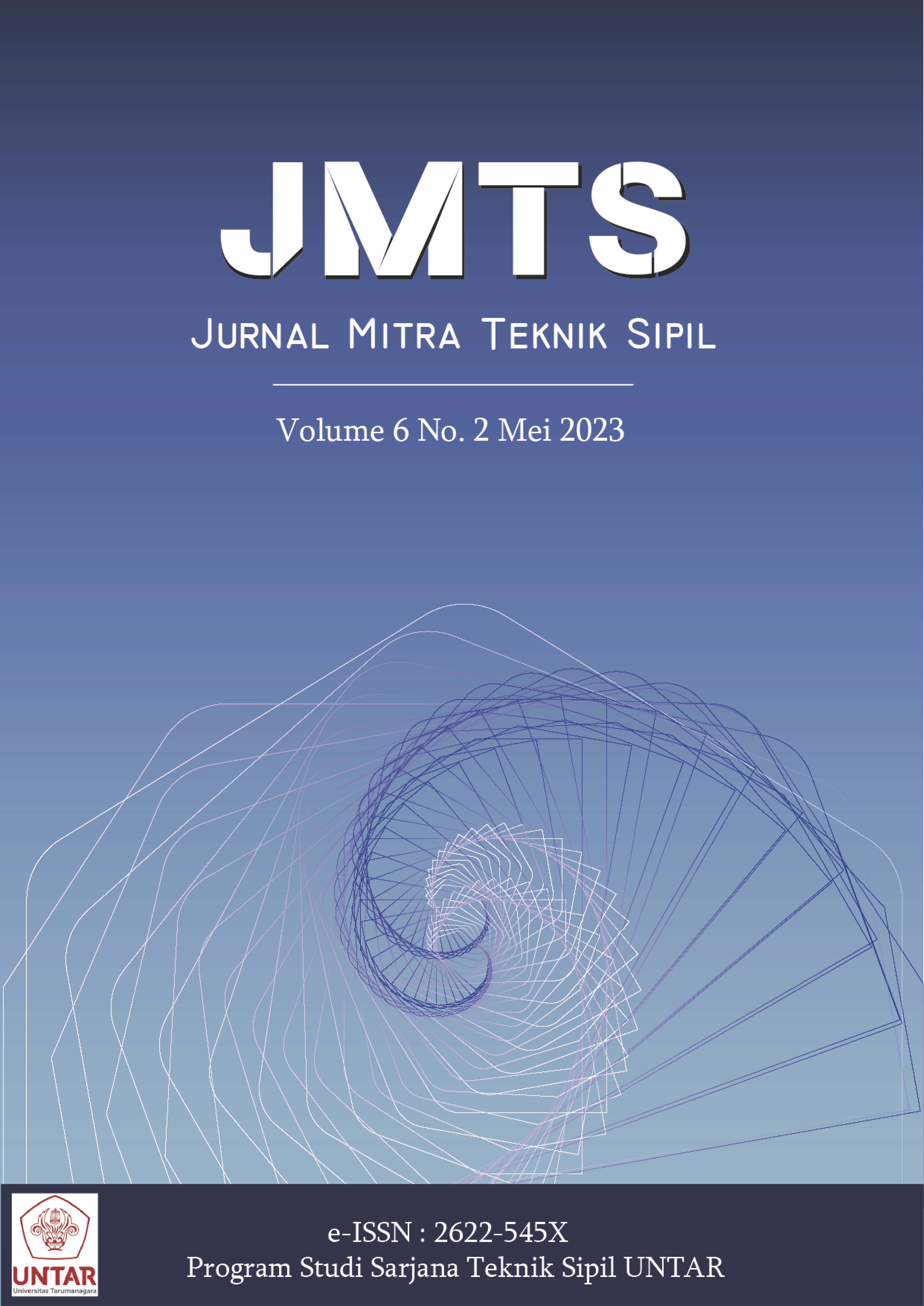PEMODELAN PARAMETER VIBRATION MONITORING TEST BERDASARKAN HASIL ITERASI NILAI RASIO REDAMAN (ξ)
Main Article Content
Abstract
The driven pile foundation is a foundation structure that not only withstands static loads but also dynamic loads due to vibrations generated during the pile driving process. It’s not impossible that the vibrations can cause damage to both the foundation structure itself and the surrounding building structures. Therefore, in this study dynamic soil modeling was carried out based on the dynamic parameters from the finite element back analysis of the Vibration Monitoring Test (VMT) which was measured using a geophone placed at a distance of 80 m from the vibration source originating from the foundation pile driving activity. The VMT parameter that was used was acceleration ay = 0,025 m/s2. The VMT parameter is modeled using a 2D finite element application and the dynamic parameter is obtained in the form of a damping ratio of 0,22 % with a percentage difference of 0,66 %. From the dynamic parameters that have been obtained, further research can be made by modeling the structure of the dynamic soil and analyzing the damage it causes.
Abstrak
Fondasi tiang pancang merupakan struktur fondasi yang tidak hanya menahan beban statis melainkan juga beban dinamik akibat getaran yang ditimbulkan ketika proses pemancangan tiang. Bukan hal yang tidak mungkin getaran tersebut dapat menyebabkan kerusakkan baik pada struktur fondasi itu sendiri maupun bagi struktur bangunan yang ada di sekitarnya. Oleh karena itu, pada penelitian ini dilakukan pemodelan tanah dinamik berdasarkan parameter dinamik dari back analysis finite element Vibration Monitoring Test (VMT) yang diukur menggunakan alat geophone yang diletakkan pada titik dan jarak 80 m dari sumber getaran yang berasal dari aktivitas pemancangan tiang fondasi dengan parameter VMT yang digunakan adalah percepatan ay = 0,025 m/s2. Parameter VMT tersebut dimodelkan menggunakan aplikasi elemen hingga 2D dan diperoleh parameter dinamik berupa rasio redaman sebesar 0,22 % dengan persentase perbedaan sebesar 0,66 %. Dari parameter dinamik yang telah diperoleh, dapat dibuat penelitian lanjutan dengan memodelkan struktur pada tanah dinamik tersebut dan dianalisis dampak kerusakan yang ditimbulkannya.
Article Details

This work is licensed under a Creative Commons Attribution-NonCommercial-ShareAlike 4.0 International License.
This work is licensed under Jurnal Mitra Teknik Sipil (JMTS) Creative Commons Attribution-ShareAlike 4.0 International License.References
Bentley. (2022). PLAXIS Connect Edition V22.01. Bentley Communities.
Brinkgreve, R. B. J. & Broere, W. (2006). PLAXIS 3D Foundation. Delft University of Technology & PLAXIS bv.
Devianta, R. (2013). Fisika Bidang Teknologi Informasi dan Komunikasi. Putra Nugraha.
Elnashai, A. S. & Sarno, L. D. (2008). Fundamentals of Earthquake Engineering. John Wiley & Sons, Ltd.
Head, J. M. & Jardine, F. M. (1992). Ground-Borne Vibrations Arising from Piling. Construction Industry Research and Information Association (CIRIA).
Koven, W. (2014). Pemodelan Potensi Hydraulic Fracture pada Saat Pengisisan Waduk Pertama Bendungan Rockfill [Diploma thesis, Universitas Komputer Indonesia]. http://repository.unikom.ac.id/id/eprint/28552
Lees, A. (2016). Geotechnical Finite Element Analysis. ICE Publishing.
Logan, D. L. (2012). A First Course in the Finite Element Method (edisi ke 5). Cengage Learning.
Ramshaw, C. L. (2002). Computation of Ground Waves from Pile Driving and Their Effect on Structures [Disertasi doktor, Durham University]. http://etheses.dur.ac.uk/3762/
Suhairy, S. A. (2000). Prediction of Ground Vibration from Railways. SP Swedish National Testing and Research Institute.
Vesic, A. S. (1977). Design of Pile Foundation. Transportation Research Board, National Academy of Sciences.



